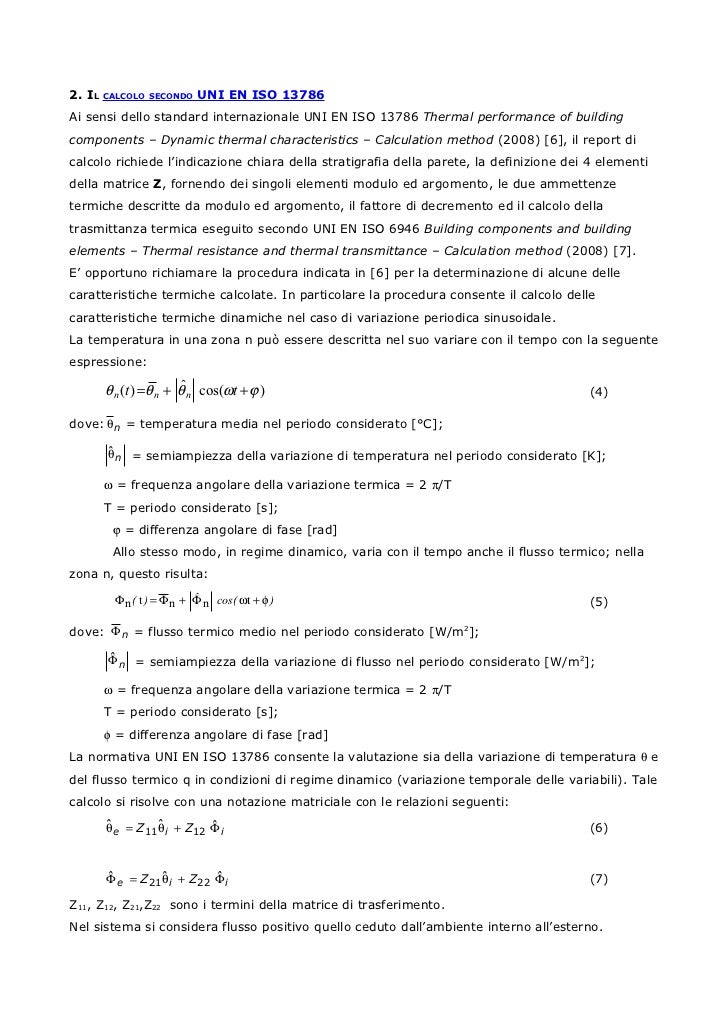
Uni En Iso 13786 Pdf Download
This data article relates to a multi-criteria process applied to slab-on-ground floor for buildings in warm climate. The input data of the analysis are the building materials with their thermal properties, sustainability characteristics and supply and installation costs. Download ultimate breaks beats rapidshare free premium. The multi-criteria analysis has been performed with the software modeFRONTIER.
The computational procedures in accordance with the UNI 13786 (Thermal performance of building components, Dynamic Thermal Characteristics, Calculation Methods) has been carried out in MatLab language. Subject area Civil engineering. More specific subject area Thermal, economic and eco-friendly performances of a set of slab-on-ground floor. Type of data Tables How data was acquired Pricelist, technical data sheet, analysed and processed output data. Data format The values are exposed in xls format. Experimental factors The building material properties have been provided by commercial data sheets.
How god taught me about prosperity kenneth hagin pdf. Uni En Iso 13788.pdf Free Download Here Norma UNI EN ISO 13788 a.a. 2005/06 Corso di.
Each building material has been processed in the multi criteria analysis. Experimental features The data have been produced through a multi objective analysis performed with modeFRONTIER optimization tool. The values are presented in terms of energy performances, costs and eco-sustainability score.
The UNI EN ISO 13786 for the assessment of the thermal performances has been processed in MatLab environment. The costs are assessed through a market survey and regional price list. The eco-sustainability score comes from the guidelines and instructions of the Itaca Protocol. Data source location The evaluations consider the city of Lecce classified, by the Italian Regulation, as climatic zone C with 1153°-days Data accessibility Data is within this article. The model configuration established is a slab-on-ground floor with maximum five layers. The presence of the same adjacent materials involves the replacement of the two layers in a single layer, reducing the overall number of layers. Several combinations of slab-on-ground floor, simulated in modeFRONTIER environment are provided in the.
In particular, the “” contains several configurations applied on a generic model of slab-on-ground floor, in which no constraints have been set on the placement of the building materials on a given layer, each material may assume an arbitrary position within the stratigraphy. The prototype of slab-on-ground floor with no constraints imposed on the layer is shown in. Prototype of slab-on-ground floor with no constraints imposed on the layer.
The subsequent Files contain stratigraphy obtained by constraints on certain layers, in particular the “” provides the results of the multi-criteria analysis characterized by the application of concrete at the first and last layer. The concrete at the first layer works as a spacer between the ground and the insulating material, while the concrete at the last layer is useful for the installation of the underfloor technological system. The prototype of slab-on-ground floor with concrete is shown in. 2. Experimental design, materials and methods The simulation has been conducted for slab-on-ground floor adapted for buildings located in warm area, considering the city of Lecce with 1153°-days (Climatic zone C) in accordance with the Italian climatic classification. The characteristics of the zone has permits to assess the objectives and constraints of the problem, in order to optimize the performances of the building component. The city of Lecce presents non-extreme winters and high aridity summer with average temperature equal to 30.3 °C.
Rainfall is concentrated in autumn with seasonal average value equal to 40 mm and 190 mm in winter. As regards the spring and summer, the average seasonal rainfall are approximately 105 mm and 60 mm, respectively. The software modeFRONTIER has been used for the multi-objective analysis. The input data of the problem are the building materials listed in a database with their physical characteristics, eco-sustainability score in accordance with the Itaca Protocol and cost from the regional price list. The methodology is presented in,,,. The statistical method to develop the analysis is DOE (Design of Experiment) and the set of initial combinations are processed according to Moga II (generic multi-objective algorithm).